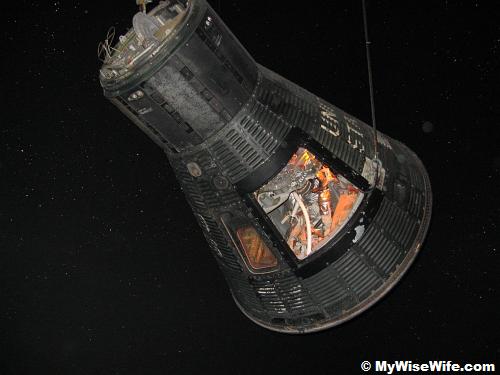ΕΠΑΙΤΙΟΙ ΑΣΤΡΟΝΑΥΤΙΚΗΣ
May 5, 1961
Launch of Alan Shepard in Freedom 7, first American
human suborbital flight
| Mission type |
Test flight |
|---|
| Operator |
NASA |
| Mission duration |
15 minutes, 22 seconds |
| Range |
487.3 kilometers (263.1 nautical miles) |
| Apogee |
187.50 kilometers (101.24 nautical miles) |
|
| Spacecraft properties |
| Spacecraft |
Mercury No.7 |
| Manufacturer |
McDonnell Aircraft |
| Launch mass |
1,830 kilograms (4,040 lb) |
| Landing mass |
1,051 kilograms (2,316 lb) |
|
| Crew |
| Crew size |
1 |
| Members |
Alan Shepard |
| Callsign |
Freedom 7 |
|
| Start of mission |
| Launch date |
May 5, 1961, 14:34:13 UTC |
| Rocket |
Redstone MRLV |
| Launch site |
Cape Canaveral LC-5 |
|
| End of mission |
| Landing date |
May 5, 1961, 14:49:35 UTC |
| Landing site |
 27.23°N 75.88°W 27.23°N 75.88°W
|
| May 15, 1963 |
| Launch of Gordon Cooper in Faith 7, the final
mission of Project Mercury
| Mission type |
Test flight |
|---|
| Operator |
NASA |
| COSPAR ID |
1963-015A |
| SATCAT № |
576 |
| Mission duration |
34 hours, 19 minutes, 49 seconds |
| Distance travelled |
878,971 kilometers (474,606 nautical miles) |
| Orbits completed |
22 |
|
| Spacecraft properties
|
| Spacecraft |
Mercury No.20 |
| Manufacturer |
McDonnell Aircraft |
| Launch mass |
1,360 kilograms (3,000 lb) |
|
| Crew |
| Crew size |
1 |
| Members |
L. Gordon Cooper, Jr. |
| Callsign |
Faith 7 |
|
| Start of mission |
| Launch date |
May 15, 1963, 13:04:13 UTC |
| Rocket |
Atlas LV-3B |
| Launch site |
Cape Canaveral LC-14 |
|
| End of mission |
| Landing date |
May 16, 1963, 23:24:02 UTC |
|
| Orbital parameters |
| Reference system |
Geocentric |
| Regime |
Low Earth |
| Perigee |
161 kilometers (87 nautical miles) |
| Apogee |
267 kilometers (144 nautical miles) |
| Inclination |
32.5 degrees |
| Period |
88.5 minutes |
|
|
|
|
|
19 May 1961
First planetary flyby (within 100,000 km of
Venus - no data returned)
| Mission type |
Venus flyby |
|---|
| Harvard designation |
1961 Gamma 1 |
| SATCAT № |
80 |
|
| Spacecraft properties |
| Spacecraft |
1VA No.2 |
| Manufacturer |
OKB-1 |
| Launch mass |
643.5 kilograms (1,419 lb) |
|
| Start of mission |
| Launch date |
February 12, 1961, 00:34:36 UTC |
| Rocket |
Molniya |
| Launch site |
Baikonur 1/5 |
|
| End of mission |
| Last contact |
19 February 1961 |
|
| Orbital parameters |
| Reference system |
Heliocentric |
|
| Flyby of Venus |
| Closest approach |
19 May 1961 |
|
May 24, 1962
Launch of Scott Carpenter in Aurora 7 |
|---|
| Mission type |
Test flight |
|---|
| Operator |
NASA |
| Harvard designation |
1962 Tau 1 |
| SATCAT № |
295 |
| Mission duration |
4 hours, 56 minutes, 5 seconds |
| Distance travelled |
122,344 kilometers (76,021 mi) |
| Orbits completed |
3 |
|
| Spacecraft properties |
| Spacecraft |
Mercury No.18 |
| Manufacturer |
McDonnell Aircraft |
| Launch mass |
1,350.0 kilograms (2,976.2 lb) |
|
| Crew |
| Crew size |
1 |
| Members |
M. Scott Carpenter |
| Callsign |
Aurora 7 |
|
| Start of mission |
| Launch date |
May 24, 1962, 12:45:16 UTC |
| Rocket |
Atlas LV-3B |
| Launch site |
Cape Canaveral LC-14 |
|
| End of mission |
| Landing date |
May 24, 1962, 17:41:21 UTC |
|
| Orbital parameters |
| Reference system |
Geocentric |
| Regime |
Low Earth |
| Perigee |
154 kilometers (83 nmi) |
| Apogee |
260 kilometers (140 nmi) |
| Inclination |
32.5 degrees |
| Period |
88.3 minutes |
| Epoch |
May 24, 1962 | | | | | | | | | | | | | | | | | | | | | | | | | | | | | | | | | | | | | | | | | | | |
|
|---|

